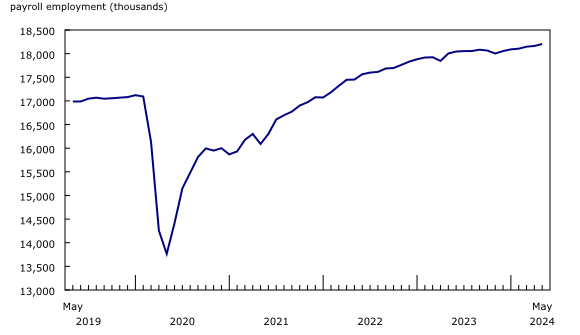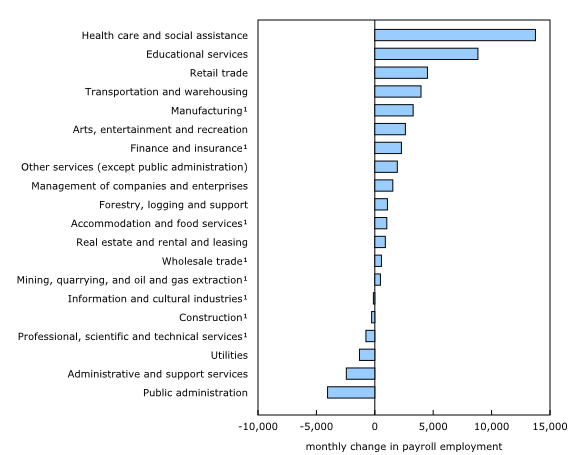The number of employees receiving pay and benefits from their employers in Canada increased for the fifth consecutive month in May, with payroll employment rising by 41,000, according to the latest data from Statistics Canada. This marks a cumulative gain of 148,900 since January.
The healthcare and social assistance sector led the gains, adding 13,800 jobs, followed by educational services with an increase of 8,800. Retail trade and transportation and warehousing also saw notable rises, adding 4,500 and 4,000 jobs, respectively.
Conversely, public administration experienced a decline, shedding 4,000 positions, while the administrative and support, waste management and remediation services sector lost 2,400 jobs. Utilities also saw a decrease of 1,300 jobs.
Despite the overall increase in payroll employment, job vacancies remained largely unchanged in May, standing at 559,700. This followed three months of consecutive declines, which saw a total reduction of 99,700 vacancies from January to April.
Payroll employment increases in May for fifth consecutive month

Sector-specific trends
In the healthcare and social assistance sector, the job gains were primarily driven by general medical and surgical hospitals, which added 5,100 positions. Community care facilities for the elderly and nursing care facilities also contributed to the increase.
Retail trade, which has experienced fluctuations in employment over the past few months, recorded a monthly increase of 4,500 jobs in May. The rise was concentrated in food and beverage retailers and motor vehicle and parts dealers.
Educational services continued its upward trend, adding 8,800 jobs in May. Elementary and secondary schools saw significant gains since February, with a cumulative increase of 24,000 jobs.
Transportation and warehousing, which has generally been trending up since December 2023, added 4,000 jobs in May. This sector’s growth was largely driven by couriers and messengers and transit and ground passenger transportation.
Payroll employment increases in nine sectors in May, led by health care and social assistance

Wages and hours
Average weekly earnings increased by 0.8% in May, reaching $1,251.77. On a year-over-year basis, this represented a 4.2% increase.
Average weekly hours remained unchanged from the previous month but saw a slight increase of 0.6% compared to the previous year, averaging 33.5 hours.
Job vacancies and labour demand
While job vacancies held steady in May, they were down significantly from the previous year, with a 28.0% decrease compared to May 2023. The job vacancy rate fell to 3.1%, just below the pre-pandemic average.
The number of job vacancies decreased in three sectors: administrative and support, waste management and remediation services; arts, entertainment and recreation; and information and cultural industries. Meanwhile, the finance and insurance sector saw an increase in vacancies.
Provincial trends
Job vacancies held steady in all provinces except New Brunswick, which saw a 21.0% decrease. Saskatchewan reported the highest job vacancy rate at 4.0%, while Prince Edward Island and Newfoundland and Labrador had the lowest rates.
Overall, the job vacancy rate decreased year-over-year in all provinces, with the most significant drops observed in Prince Edward Island, Quebec, and Newfoundland and Labrador.
Long-term trends
Over the past two years, the job vacancy rate in Canada has notably decreased from its peak in May 2022. The accommodation and food services sector recorded the largest decline in job vacancies, followed by construction, manufacturing, and professional, scientific, and technical services. However, the healthcare and social assistance sector remained above its pre-pandemic levels.
Job vacancies and job vacancy rate – seasonally adjusted
| Sector | Payroll Employment (thousands) | Job Vacancies (thousands) | Job Vacancy Rate (%) |
|---|---|---|---|
| Sector aggregate | 17,240.1 | 559.7 | 3.1 |
| Agriculture, forestry, fishing and hunting | 239.9 | 8.9E | 3.6E |
| Mining, quarrying, and oil and gas extraction | 204.7 | 5.1 | 2.5 |
| Utilities | 135.8 | F | F |
| Construction | 1,173.9 | 43.9 | 3.6 |
| Manufacturing | 1,559.2 | 37.6 | 2.4 |
| Wholesale trade | 819.9 | 19.0 | 2.3 |
| Retail trade | 2,003.7 | 55.1 | 2.7 |
| Transportation and warehousing | 839.9 | 30.8 | 3.5 |
| Information and cultural industries | 362.1 | 4.8 | 1.3 |
| Finance and insurance | 841.5 | 24.2 | 2.8 |
| Real estate and rental and leasing | 293.8 | 7.0 | 2.3 |
| Professional, scientific and technical services | 1,223.0 | 37.9 | 3.0 |
| Management of companies and enterprises | 122.7 | 2.3 | 1.8 |
| Administrative and support, waste management and remediation services | 825.5 | 25.4 | 3.0 |
| Educational services | 1,459.1 | 19.7 | 1.3 |
| Health care and social assistance | 2,366.6 | 120.5 | 4.8 |
| Arts, entertainment and recreation | 314.3 | 6.8 | 2.1 |
| Accommodation and food services | 1,307.9 | 68.4 | 5.0 |
| Other services (excluding public administration) | 576.1 | 27.2 | 4.5 |
| Public administration | 570.3 | 13.0 | 2.2 |
| Provinces and territories | |||
| Newfoundland and Labrador | 210.0 | 4.9 | 2.3 |
| Prince Edward Island | 70.1 | 1.4 | 1.9 |
| Nova Scotia | 450.3 | 15.2 | 3.3 |
| New Brunswick | 305.1 | 8.4 | 2.7 |
| Quebec | 3,850.8 | 124.0 | 3.1 |
| Ontario | 6,712.5 | 194.6 | 2.8 |
| Manitoba | 606.7 | 20.2 | 3.2 |
| Saskatchewan | 492.6 | 20.7 | 4.0 |
| Alberta | 2,069.4 | 70.5 | 3.3 |
| British Columbia | 2,414.3 | 96.6 | 3.8 |
| Yukon | 19.8 | 0.9E | 4.6 |
| Northwest Territories | 22.5 | 1.4E | 6.0E |
| Nunavut | 16.1 | 0.7E | 4.3E |
p preliminary
E use with caution
F too unreliable to be published






